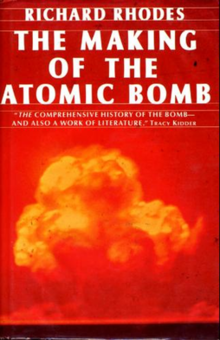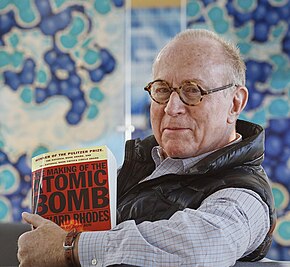The Making of the Atomic Bomb
 | |
| Author | Richard Rhodes |
|---|---|
| Subject | Manhattan Project |
| Publisher | Simon & Schuster |
Publication date | 1986 |
| Publication place | United States |
| Media type | Print (hardcover & paperback), E-book, Audio |
| Pages | 886 (hardcover) |
| ISBN | 978-0-671-44133-3 |
| OCLC | 231117096 |
| 623.4/5119/09 19 | |
| LC Class | QC773 .R46 1986 |
The Making of the Atomic Bomb is a history book written by the American journalist and historian Richard Rhodes, first published by Simon & Schuster in 1987. The book won multiple awards, including Pulitzer Prize for General Non-Fiction. The narrative covers people and events from early 20th century discoveries leading to the science of nuclear fission, through the Manhattan Project and the atomic bombings of Hiroshima and Nagasaki.
Background
[edit]Before writing The Making of the Atomic Bomb, Richard Rhodes already authored several fiction books, and worked as an independent journalist. He liked science writing, though his only training, in his own words, was "a course at Yale that we called Physics for Poets". When he started to work on the book he found out that "the early papers in nuclear physics were written very clearly".[1]
Reception
[edit]
The book was praised both by historians and former Los Alamos weapon engineers and scientists, and is considered to be a general authority on early nuclear weapons history, as well as the development of modern physics in general, during the first half of the 20th century. Nobel Laureate I. I. Rabi, one of the prime participants in the dawn of the atomic age, called it "an epic worthy of Milton. No where else have I seen the whole story put down with such elegance and gusto and in such revealing detail and simple language which carries the reader through wonderful and profound scientific discoveries and their application."[2] As reported by The New York Times, Rabi's wife "read him the whole book, and he was pleased with it".[1]
Late Sir Solly Zuckerman wrote in his review: "I have no doubt that his book will stand for years to come as an authoritative account of the way our nuclear age started. Above all, lengthy it is, it will be enjoyed as a magnificent read."[3]
The historian of science Lawrence Badash writes positively about the book, but notes Rhodes' descriptions of sketchy biographies unconvincing: "'human interest' material of questionable accuracy becomes psycho-babble", though he notes that "the book is accurate and the characters are well drawn". He concludes that "Altogether Rhodes has produced the most readable, exciting and just book to date that covers both the bomb and the preceding four decades".[4]
William J. Broad praised the book in The New York Times review, writing that it "offers not only the best overview of the century's pivotal event, but a probing analysis of what it means for the future." He especially noted the vast bibliography, "the characters speak in their own voices, in long paragraphs of direct quotation".[1] Another reviewer writes that "If it is the bomb which defines the twentieth century as at once dreadful and rewarding ... then the present book captures this range", and also praised the extensive bibliography.[5] Another review calls it "an exceptionally well-written account of the building and use of the first nuclear weapons".[6]
Sally Smith Hughes notes that while "Rhodes is neither a scientist nor science writer", this "may explain the freshness of his approach and his ability to convey difficult science in layman's terms." She notes the usage of oral histories by the author: Rhodes writes about 21 participants of the events who "generously made time for interviews and correspondence"; he also used oral histories collected by the American Institute of Physics.[7]
Barton Bernstein praised the book, and called it "a compelling book of drama and tragedy, of passion and commitment, and of moral lament. It is historical journalism on a grand scale, with rich detail, colorful scenes, recreated conversations, vivid portraits, and gripping vignettes chronicling the lengthy scientific and political roads to Hiroshima, and briefly beyond". Besides that, his review also contains criticism, as he writes that sometimes "narrative strategy ... neglects analysis, sometimes sacrifices the important to the vivid, and encourages an uncritical use of sources and possibly even skimpy archival research".[8]
Angelo Collins of Stanford University also praised the book, noting that it "is not a pleasure to read (it is thought provoking and makes the reader uneasy) and it is not easy to read (it is long and there are many characters and many settings). But it is fascinating."[9] Carol S. Gruber writes that the "comprehensiveness and the framework within which its main story unfolds, it broadens and deepens our understanding of the familiar subject; and it is a very good read."[10]
Robert Seidel in his essay on the books that cover the Manhattan Project writes that "Rhodes's account is more comprehensive, thoughtful, and accurate than the standard popular history ... the book is a "good read" and makes use of reliable sources critically. We would ask little more of a professional history."[11]
Barton C. Hacker notes that it "reads much like a novel and, like a good novel, can be hard to put down", but also writes about what the book lacks:[12]
What the book lacks, however, is any sustained attention to the institutional shaping and constraint of events. A grant from the Rockefeller Foundation or a Nobel Prize arrives as a virtual deus ex machina just when a scientist needs to study in Berlin or flee fascism - no hint is given that such awards might be something other than natural phenomena. Even the Manhattan Project often seems more a matter of a physicist's views clashing with a soldier's, or a daring foray into the war zone to learn the status of German nuclear research, than the rapid construction and widespread operations of an enterprise that rivaled in size the prewar American automobile industry. Conducting experiments fills many more pages than building production plants. ... I suspect Rhodes really wanted to write the epic of the atomic bomb, an "Atomiad" if you will. Maybe he has.
Matthew Bunn notes Rhodes descriptions of the Hiroshima and Nagasaki bombings, writing that they are "excruciating, densely layered with gruesome but telling first-hand accounts of the horrors the bombs inflicted"; he called the book "a wide-ranging tale of the physics and engineering of the bomb, the personalities involved, and the larger story of how society came to think about war".[13]
In 2023, the book became popular among artificial intelligence researchers. The Atlantic reported that "A generation of AI researchers treat Richard Rhodes's seminal book like a Bible as they develop technology with the potential to remake—or ruin—our world."[14]
Awards
[edit]- 1988 Pulitzer Prize for General Non-Fiction[15]
- 1987 National Book Award for Nonfiction[16]
- 1987 National Book Critics Circle Award[17]
Subsequent books
[edit]In 1992, Rhodes followed it up by compiling, editing, and writing the introduction to an annotated version of The Los Alamos Primer, by Manhattan Project scientist Robert Serber. The Primer was a set of lectures given to new arrivals at the secret Los Alamos Laboratory during wartime to get them up to speed about the prominent questions needing to be solved in bomb design, and had been largely declassified in 1965, but was not widely available.[18][19]
In 1994, Rhodes published Nuclear Renewal: Common Sense about Energy detailing the history of the nuclear power industry in the United States, and future promises of nuclear power.[20] In 1995 he published a sequel to The Making of the Atomic Bomb, Dark Sun: The Making of the Hydrogen Bomb, which told the story of the atomic espionage during World War II, the debates over whether the hydrogen bomb ought to be produced, and the eventual creation of the bomb and its consequences for the arms race.[21] In 2007, Rhodes published Arsenals of Folly: The Making of the Nuclear Arms Race, a chronicle of the arms buildups during the Cold War, especially focusing on Mikhail Gorbachev and the Reagan administration.[22][23] The Twilight of the Bombs, the fourth and final volume in his series on nuclear history, was published in 2010. The book documents, among other topics, the post-Cold War nuclear history of the world, nuclear proliferation, and nuclear terrorism.[24]
References
[edit]- ^ a b c Broad, William J. (February 8, 1987). "The Men Who Made the Sun Rise". 7. The New York Times (Late City Final ed.). New York. p. 1. ISSN 0362-4331. Retrieved August 6, 2012.
- ^ The book's entry on Amazon.com has this quote under "Editorial Reviews"
- ^ Zuckerman, Solly (August 22, 1988). "The Making of the Atomic Bomb". The New Republic. Vol. 199, no. 8. p. 38. Retrieved August 2, 2023.
- ^ Badash, Lawrence (July 1987). "The men behind the bomb". Nature. 328 (6128): 301–302. Bibcode:1987Natur.328..301B. doi:10.1038/328301a0. ISSN 0028-0836.
- ^ "Reviewed Work: The Making of the Atomic Bomb by Richard Rhodes". Social Studies of Science. 20 (3): 565–566. August 1990. doi:10.1177/030631290020003009. JSTOR 285000. S2CID 220880171.
- ^ Wang, Zuoyue (October 1989). "Reviewed Work: The Making of the Atomic Bomb by Richard Rhodes". Technology and Culture. 30 (4): 1078–1081. doi:10.2307/3106232. JSTOR 3106232.
- ^ Hughes, Sally Smith (1988). "Reviewed Work: The Making of the Atomic Bomb by Richard Rhodes". The Oral History Review. 16 (1): 187–189. doi:10.1093/ohr/16.1.187. JSTOR 3674840.
- ^ Bernstein, Barton J. (1990). "An Analysis of 'Two Cultures': Writing about the Making and the Using of the Atomic Bombs". The Public Historian. 12 (2): 83–107. doi:10.2307/3378693. JSTOR 3378693.
- ^ Collins, Angelo (1988). "Reviewed Work: The Making of the Atomic Bomb by Richard Rhodes". The American Biology Teacher. 50 (8): 532. doi:10.2307/4448825. JSTOR 4448825.
- ^ Gruber, Carol S. (May 22, 1987). "Reviewed Work: The Making of the Atomic Bomb by Richard Rhodes". Science. 236 (4804): 974–975. doi:10.1126/science.236.4804.974. JSTOR 1699656. PMID 17812757.
- ^ Seidel, Robert (September 1990). "Books on the Bomb". Isis. 81 (3): 519–537. doi:10.1086/355462.
- ^ Hacker, Barton C. (June 1990). "Reviewed Work: The Making of the Atomic Bomb by Richard Rhodes". The American Historical Review. 95 (3): 935–936. doi:10.2307/2164503. JSTOR 2164503.
- ^ Bunn, Matthew (May 1988). "The Bomb's Brilliant History". Arms Control Today. 18 (4): 29–30. JSTOR 23623906.
- ^ Warzel, Charlie (July 20, 2023). "The Real Lesson From 'The Making of the Atomic Bomb'". The Atlantic. Archived from the original on July 22, 2023. Retrieved September 5, 2023.
- ^ "The 1988 Pulitzer Prize Winner in General Nonfiction". The Pulitzer Prizes | Columbia University. n.d. Archived from the original on 5 March 2022. Retrieved 5 December 2022.
For a distinguished book of non-fiction by an American author that is not eligible for consideration in any other category, Three thousand dollars ($3,000).
- ^ "The Making of the Atomic Bomb | Winner, National Book Awards 1987 for Nonfiction". National Book Foundation. n.d. Archived from the original on 29 June 2022. Retrieved 5 December 2022.
- ^ "1987 Winners & Finalists". National Book Critics Circle. Retrieved April 20, 2021.
- ^ Settle, Frank A. (1992). "Review of The Los Alamos Primer: The First Lectures On How to Build an Atomic Bomb". The Journal of Military History. 56 (4): 710–711. doi:10.2307/1986188. ISSN 0899-3718. JSTOR 1986188. Retrieved August 4, 2023.
- ^ Dyson, Freeman J. (1992). "Dragon's Teeth". Science. 256 (5055): 388–389. doi:10.1126/science.256.5055.388. ISSN 0036-8075. JSTOR 2877089. Retrieved August 4, 2023.
- ^ Cooper, Richard (May 1, 1994). "Nuclear Renewal: Common Sense about Energy". Foreign Affairs. 73 (3).
- ^ "The Race to Armageddon". archive.nytimes.com.
- ^ Rhodes, Richard (October 1, 2007). "Arsenals of Folly: The Making of the Nuclear Arms Race". Alfred A. Knopf – via cisac.fsi.stanford.edu.
- ^ Walker, Martin (November 25, 2007). "Smoking Guns and Mushroom Clouds". The New York Times – via NYTimes.com.
- ^ Thompson, Nicholas (August 26, 2010). "Nuclear Family". The New York Times – via NYTimes.com.
